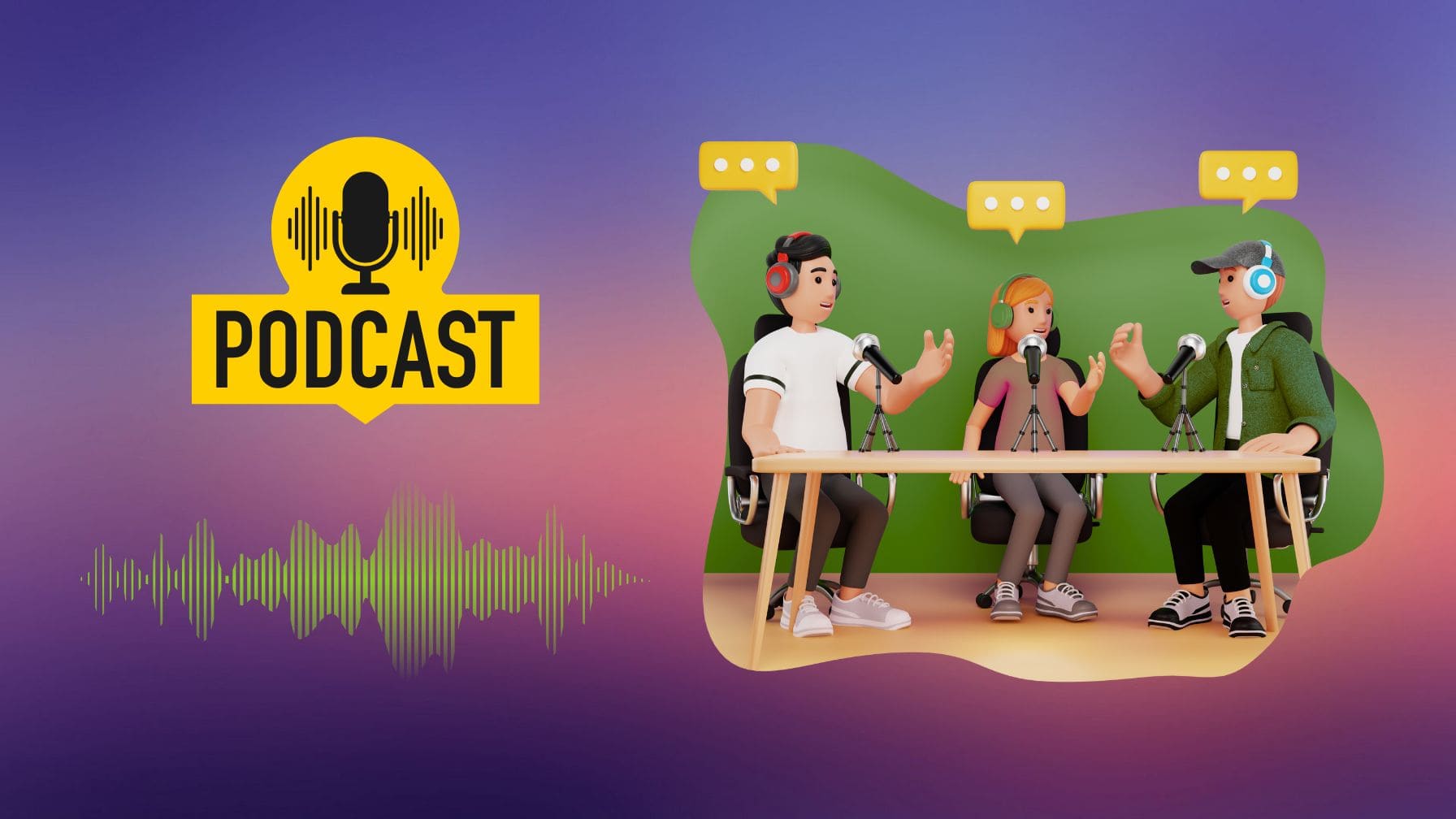WHAT WE HAVE ON THIS PAGE
- Editor’s Choice
- Top Podcast Genres in the US
- Global Podcast Listener Growth Trends
- How Many Active Podcasts Are There
- Preferred Podcast Formats by Aspiring Podcasters
- How Many People Listen to Podcasts
- Demographics of Podcast Listeners
- Podcast-Listening Situations
- Podcast Advertising Revenue
- Average Listening Time per User
- Top Benefits of Podcast Listening: Habitual Listeners vs. Dabblers
- Language and Regional Distribution of Podcasts
- Listener Engagement and Retention Rates
- How People Discover Podcasts
- Monetization Models Used by Podcasters
- Mobile vs Desktop Podcast Consumption
- Reasons Why People Prefer Video Podcasts
- Impact of Video Podcasts on Audio Podcast Growth
- Top Countries by Podcast Consumption
- Recent Developments in the Podcast Industry
- Conclusion
- Sources
In 2025, podcasts have become an integral part of daily life for millions worldwide. Whether it’s during a morning commute, an evening jog, or while doing household chores, people are tuning in to stay informed, entertained, and connected. The podcasting landscape has evolved significantly, reflecting changes in technology, media consumption habits, and audience preferences.
Editor’s Choice
- 584.1 million people globally are podcast listeners in 2025, marking a 6.83% year-over-year increase.
- The United States boasts 158 million monthly podcast listeners, accounting for 55% of its population aged 12 and above.
- There are over 4.52 million podcasts worldwide as of May 2025, with nearly 487,200 new shows launched in the past three months.
- Podcast listeners spend an average of 7 hours per week tuning into their favorite shows.
- YouTube has emerged as the leading platform for podcast consumption, with 33% of U.S. weekly podcast listeners using the service.
- Video podcasts are gaining popularity, with 40% of U.S. podcast listeners opting for watchable content.
- The global podcast industry is valued at approximately $39.63 billion in 2025.
Top Podcast Genres in the US
- Comedy is the most popular podcast genre, preferred by 22% of listeners.
- News podcasts follow closely, capturing the attention of 21% of the audience.
- True Crime holds strong appeal with 18% listener interest.
- Both Sport and Health/Fitness podcasts are favored by 17% of respondents.
- Religion/Faith and Politics genres are tied, each attracting 16% of podcast listeners.
- Self Help/Productivity content is consumed by 15% of the audience.
- Finance-related podcasts engage 13% of listeners.
- Scripted Comedy has a niche but notable following at 11%.
- Game Show themed podcasts attract 10% of users.
- Pop Culture discussions are enjoyed by 9% of the audience.
- Scripted Drama is the least popular on the list, with 8% listener share.
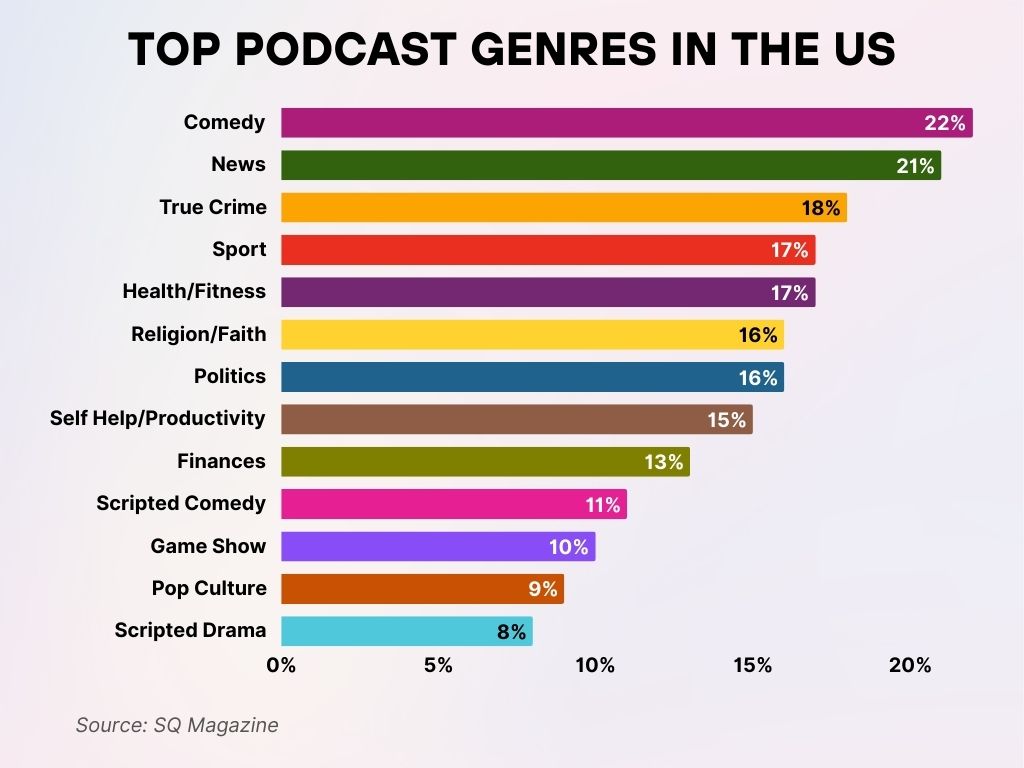
Global Podcast Listener Growth Trends
- The global podcast audience reached 584.1 million in 2025, indicating a steady growth trajectory.
- Projections estimate that the number of podcast listeners worldwide will hit 651.7 million by 2027.
- In the Asia-Pacific region, countries like Indonesia and Thailand have high engagement, with 59% and 54% of consumers, respectively, listening to podcasts for at least an hour per week.
- The United States continues to lead in podcast consumption, with 158 million monthly listeners in 2025.
- The integration of podcasts into daily routines has contributed to their growth, with many listeners tuning in during commutes, workouts, and household activities.
- The rise of smart speakers and voice assistants has made accessing podcasts more convenient, further boosting listener numbers.
- Educational and informative content remains a significant driver of podcast popularity, catering to audiences seeking continuous learning opportunities.
How Many Active Podcasts Are There
- As of May 2025, there are over 4.52 million podcasts globally, with nearly 487,200 new shows launched in the past three months.
- The number of active podcasts has seen a significant increase, reflecting the medium’s growing popularity and accessibility.
- Buzzsprout, a leading podcast hosting platform, reports 120,382 active podcasts in April 2025.
- The surge in podcast creation is attributed to the ease of content production and the availability of user-friendly recording tools.
- Niche topics and specialized content have found dedicated audiences, encouraging more creators to enter the podcasting space.
- The diversification of podcast genres has led to a broader range of content, appealing to various listener interests.
- The monetization potential of podcasts has incentivized creators to produce consistent and high-quality content.
Preferred Podcast Formats by Aspiring Podcasters
- 43% of over 1,500 respondents plan to launch a Solo Show, making it the most popular format.
- 29% intend to produce Interview-style podcasts.
- 23% are interested in starting a Co-Hosted podcast.
- Only 5% of aspiring podcasters prefer a Roundtable format.
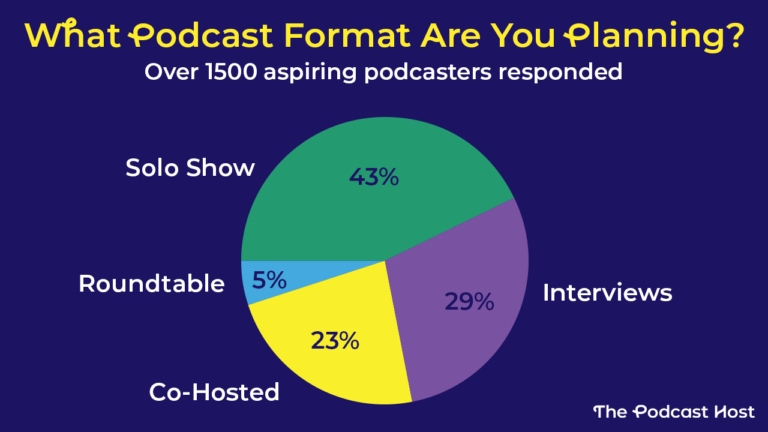
How Many People Listen to Podcasts
- In 2025, 584.1 million people globally are podcast listeners, marking a 6.83% increase from the previous year.
- The United States has 158 million monthly podcast listeners, representing 55% of its population aged 12 and above.
- Weekly podcast listenership in the U.S. stands at 98 million, accounting for 34% of the population.
- The average podcast listener spends about 7 hours per week tuning into various shows.
- Podcasts have become a preferred medium for consuming news, entertainment, and educational content.
- The convenience of on-demand listening has contributed to the medium’s widespread adoption.
- The integration of podcasts into streaming platforms like Spotify and Apple Music has expanded their reach.
- The rise of video podcasts has attracted new audiences who prefer visual content alongside audio.
- Podcasts have become a valuable tool for brands and marketers to engage with target audiences through sponsored content and advertisements.
Demographics of Podcast Listeners
Understanding who listens to podcasts in 2025 is essential for brands, creators, and platforms aiming to engage targeted audiences. The demographic landscape continues to diversify as the medium becomes mainstream.
- In the U.S., 63% of podcast listeners are aged between 18 and 44, with the 25–34 age bracket making up the largest single group.
- The gender split remains relatively balanced: 51% male and 48% female, with the remaining 1% identifying as non-binary or other.
- Urban listeners dominate, with 67% of podcast consumers residing in metropolitan or suburban areas.
- Education levels skew higher: over 58% of listeners hold a college degree or higher.
- Income levels are rising among listeners—48% report earning more than $75,000 annually, reflecting an affluent and desirable audience for advertisers.
- Hispanic/Latino and African American communities represent 15% and 13% of U.S. podcast listeners, respectively, with growth expected as culturally diverse content expands.
- Gen Z listenership is growing fast, with 37% of 18–24-year-olds now listening weekly.
- Podcasts are particularly popular among knowledge-seekers: 54% of listeners report tuning in for educational content on a regular basis.
- Mobile-first consumption is highest among millennials and Gen Z, with 85% accessing shows via smartphone apps.
- Among retirees (65+), adoption is slower but rising—now at 9%, thanks in part to simplified tech experiences and health-themed content.
Podcast-Listening Situations
When do people actually listen to podcasts? This data reveals the most common scenarios where US adults consume podcast content, including while multitasking at home, during commutes, or while exercising. The stats also highlight notable differences between male and female listening habits.
- 49% of US adults listen to podcasts while doing household chores (e.g., cleaning, tidying up). This includes 43% of males and 55% of females.
- 42% listen while commuting to or from work, whether driving or using public transport. 44% of males and 40% of females reported this habit.
- 29% enjoy podcasts while working out or doing sports. This includes 32% of males and 26% of females.

Podcast Advertising Revenue
Podcasting in 2025 is not just a content medium, it’s a booming ad channel with billions in revenue and growing brand interest.
- The global podcast ad revenue is estimated at $4.2 billion in 2025, up from $3.1 billion the year before.
- In the U.S. alone, podcast ad spending reached $2.3 billion, driven by major sectors like tech, finance, and wellness.
- Host-read ads remain the most trusted format, with 69% of listeners saying they’re more likely to consider products promoted this way.
- Dynamic ad insertion now accounts for 38% of all podcast advertising—a rise from 31% last year.
- Branded podcasts are on the rise, with companies like Nike, Microsoft, and Shopify investing in storytelling-based content marketing.
- The average CPM (cost per mille) for podcasts is now $25–$40, depending on audience size and engagement.
- Advertisers are increasingly targeting niche shows, with 45% of campaigns focused on podcasts with under 50,000 downloads per episode.
- Programmatic advertising has seen adoption double year-over-year, now comprising 20% of all podcast ad transactions.
- Measurement tools and analytics have improved dramatically, allowing marketers to track conversion lift, brand recall, and listener engagement.
- Direct-to-consumer brands remain top spenders, but B2B and SaaS companies have notably increased ad spend this year.
Average Listening Time per User
Podcast engagement is deepening, with users devoting more time to their favorite content and integrating listening into everyday life.
- The average weekly listening time per user in 2025 is 7 hours and 12 minutes, up from 6 hours and 35 minutes.
- Daily podcast listeners—those tuning in at least once per day—account for 29% of the audience.
- Among millennials, weekly listening time surpasses 8 hours, making them the most dedicated demographic.
- Power users (top 10% of listeners) consume 15+ hours of podcast content per week on average.
- 47% of listeners report finishing episodes entirely, suggesting strong content retention and loyalty.
- Weekend listening is increasing, especially for entertainment and long-form narrative content.
- Smart speaker usage contributes significantly to at-home podcast time, especially among families.
- Commuter-based listening dropped slightly as remote work became more common, but gym and walking sessions have compensated.
- Short-form podcasts (under 10 minutes) have grown in popularity, with over 35% of users now including them in their weekly mix.
- Video podcasts are increasing session times, with users watching or listening to 20% longer episodes on average.
Top Benefits of Podcast Listening: Habitual Listeners vs. Dabblers
- 80% of habitual listeners use podcasts to accompany household chores, compared to 54% of dabblers.
- 78% of habitual listeners enjoy podcasts while traveling or in the car, vs. 64% of dabblers.
- 77% of habitual users find audio content helps keep them company, while only 58% of dabblers agree.
- 74% of habitual listeners use podcasts while walking or exercising, compared to 60% of dabblers.
- 69% of habitual listeners value voices and conversation when alone, compared to 50% of dabblers.
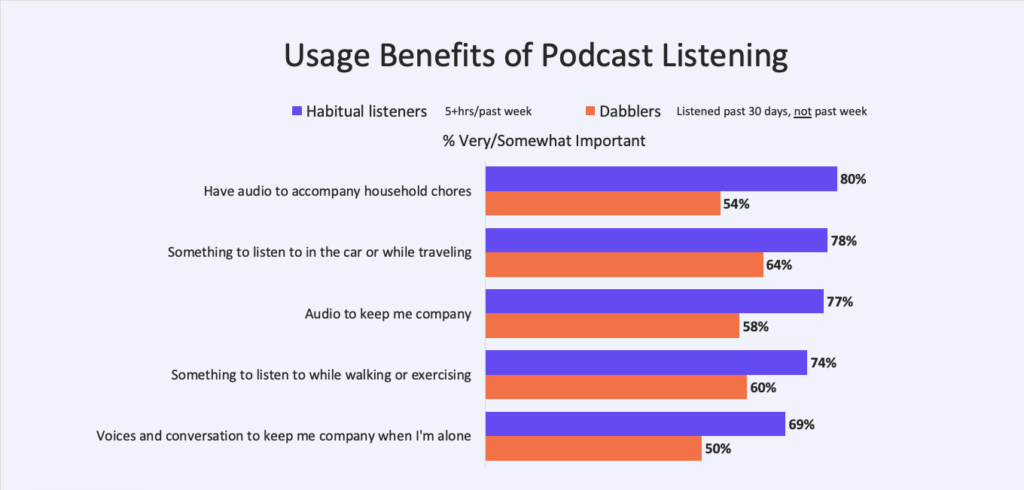
Language and Regional Distribution of Podcasts
The podcasting ecosystem in 2025 is more global and multilingual than ever before. The surge in local-language content is bridging gaps in access and audience relevance.
- 67% of all new podcasts in 2025 are published in languages other than English.
- English remains dominant but now accounts for only 28% of total podcast content.
- Spanish-language podcasts are growing rapidly, now making up 14% of global shows.
- Regional markets like Brazil and India have become hotspots for podcast production, with Portuguese and Hindi emerging as top languages.
- African podcasting is on the rise, with Nigeria and Kenya driving most of the growth in English and Swahili.
- European content creation surged in 2025, particularly in German, French, and Polish language podcasts.
- Podcasts in Mandarin Chinese have grown by 38% year-over-year, partly due to increased government support for educational content.
- Localized content in Southeast Asia (e.g., Bahasa Indonesia, Thai, Vietnamese) is driving listener engagement among first-time audiences.
- Cross-language podcast syndication—translating and publishing content in multiple languages—is up by 22%.
- Hosting platforms like Spotify and Acast now support automated multi-language distribution, aiding regional podcasting efforts.
Listener Engagement and Retention Rates
In 2025, engagement quality is prioritized over volume. Podcasters are focused on retaining loyal listeners, and the data shows the effort is paying off.
- The average episode completion rate stands at 68%, slightly higher than last year’s 64%.
- 52% of listeners follow their favorite shows on more than one platform, suggesting cross-platform loyalty.
- Weekly active listeners (those who listen to 3+ episodes per week) account for 43% of the total audience.
- Listener churn dropped by 11% year-over-year, indicating stronger brand affinity and content stickiness.
- Podcasts under 30 minutes show the highest retention rates, averaging 73% completion.
- Series-style shows retain 82% of listeners from episode to episode, compared to 64% for standalone episodes.
- Over 60% of listeners report interacting with podcast communities through social media, comments, or live Q&As.
- Gamified content (e.g., quizzes, choose-your-own-adventure episodes) has increased session time by 12%.
- Podcast newsletters and episode recaps via email see an open rate of 42%, far above average for email marketing.
- Listener loyalty programs—such as bonus content or merchandise—have improved month-over-month retention by 15% for participating shows.
How People Discover Podcasts
- 40% of listeners find new podcasts through a listening app’s directory, making it the top discovery method.
- 18.3% rely on recommendations from friends, family, or communities.
- 15.2% of podcast discoveries happen via social media platforms.
- 13.6% of users use Google searches to find podcasts.
- 13% come across new podcasts by simply browsing online.
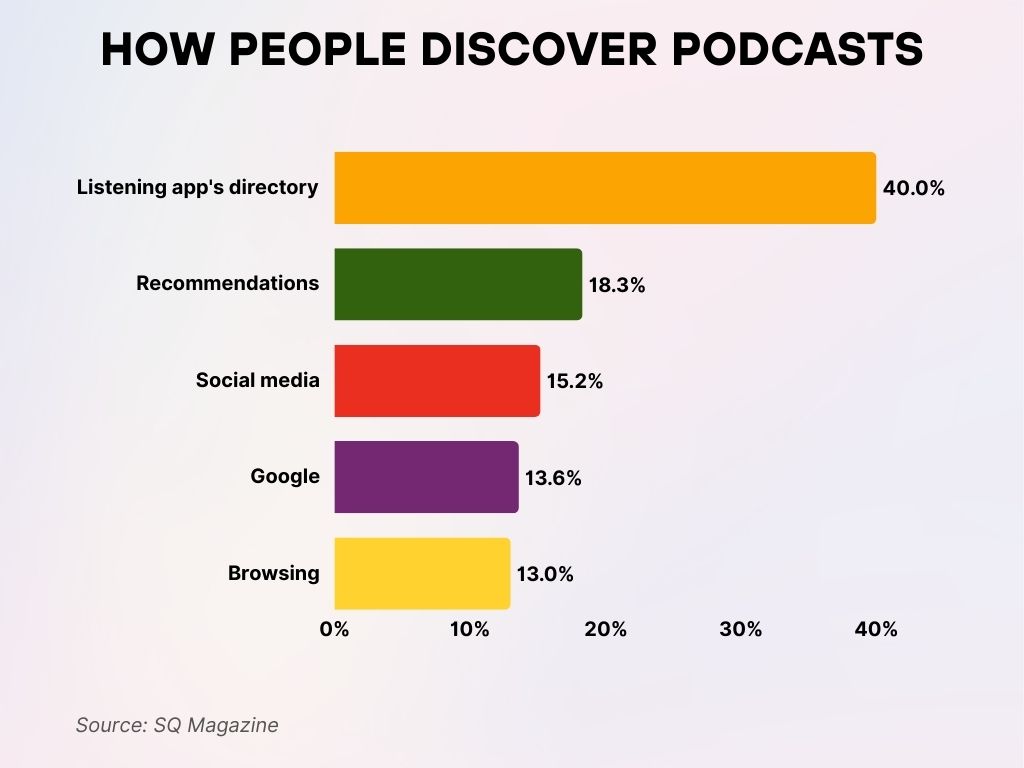
Monetization Models Used by Podcasters
Creators in 2025 have a broader set of monetization tools, from traditional ads to direct audience support and brand partnerships.
- 74% of podcasters monetize their content.
- Sponsorships and host-read ads remain the most common model, used by 58% of monetized podcasts.
- Subscription-based content (via Patreon, Supercast, etc.) grew to 29% of all monetized shows.
- Programmatic ads now account for 26% of podcast revenue, thanks to better targeting tools.
- Affiliate marketing is used by 31% of mid-sized podcasters to supplement income.
- Branded content and co-productions—where companies fund full episodes or series—make up 11% of revenue across the top 1,000 podcasts.
- Tip jars and donation platforms like Buy Me a Coffee are popular with smaller creators, adopted by 22% of podcasters.
- Crowdfunded podcasts (funded by listeners at launch) increased by 19%, especially in niche genres like investigative journalism.
- Merchandise sales—apparel, mugs, and prints—generated revenue for 17% of creators.
- Course and service upsells (e.g., coaching, workshops) are used by 12% of business-focused podcasters as a primary revenue stream.
Mobile vs Desktop Podcast Consumption
Listeners in 2025 overwhelmingly favor mobile access, but desktops still hold relevance for certain contexts and content types.
- 83% of podcast listening happens on mobile devices, up from 79% last year.
- iOS users represent 58% of all podcast app traffic, while Android accounts for 39%.
- Desktop listening, mostly via websites and workplace streams, accounts for 12% of total plays.
- Smart speakers are used by 9% of podcast listeners, especially for family and home-focused content.
- Tablet usage is steady at 4%, often for video podcasts or children’s content.
- Podcasts embedded in newsletters or blogs are increasingly played on desktops, contributing to 7% of discovery.
- Mobile users are 3x more likely to binge-listen to multiple episodes in one session.
- Notification-based episode reminders on mobile have improved listen-through rates by 18%.
- Mobile-first platforms like Pocket Casts and Overcast maintain high engagement among power users.
- Podcasts accessed through car dashboards (Apple CarPlay, Android Auto) now account for 14% of total mobile streams.
Reasons Why People Prefer Video Podcasts
- 51% prefer video podcasts to see facial expressions and reactions from hosts and guests.
- 50% say video helps them better focus on the podcast content.
- 34% enjoy watching influential or celebrity guests on screen.
- 25% value the option to read closed captioning or subtitles.
- 16% like to see the podcast setup and equipment used during recording.
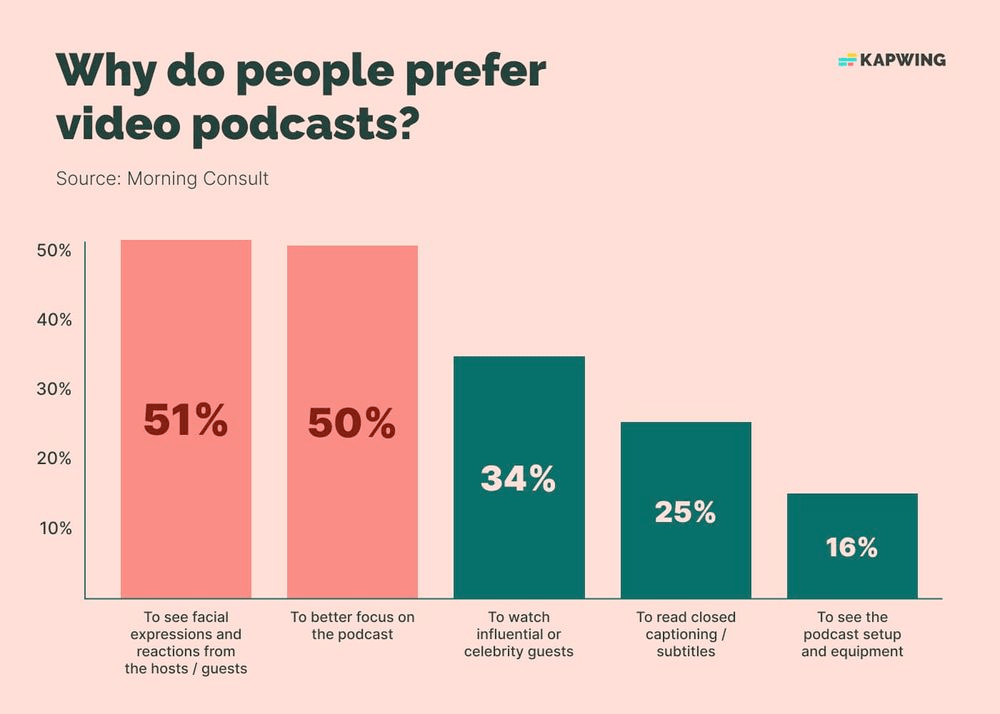
Impact of Video Podcasts on Audio Podcast Growth
The hybridization of audio and video content has reshaped the podcasting landscape, particularly among Gen Z and younger millennials.
- 40% of all podcast listeners in 2025 consume at least one video podcast each week.
- YouTube remains the dominant video platform for podcasts, with 33% of all podcast watchers using it weekly.
- TikTok-style short clips from long-form podcasts are now a top discovery method for 22% of new listeners.
- Podcasters who include video see 27% higher engagement than their audio-only counterparts.
- Podcasts with simultaneous video releases enjoy 35% more shares on social media.
- Spotify video podcast plays increased by 46% compared to last year.
- Many shows now produce dedicated video segments separate from their audio feed, especially for interviews and behind-the-scenes content.
- Influencers and content creators who started on video platforms are increasingly launching podcast spin-offs.
- Video podcasting has attracted more sponsorship dollars, particularly from brands in beauty, fashion, and tech.
- Audio-only purists remain a strong segment—45% of podcast listeners say they prefer to listen without visual elements.
Top Countries by Podcast Consumption
Podcasting in 2025 is a truly international medium, with major listening hubs across continents.
- The United States leads globally with 158 million monthly podcast listeners.
- Brazil ranks second in engagement, with 68 million monthly listeners.
- Indonesia has seen explosive growth, with 42 million active listeners.
- Germany boasts 21 million regular podcast consumers, making it Europe’s largest market.
- India is catching up quickly, with 38 million monthly listeners, driven by regional-language content.
- The UK reports 17 million monthly podcast users, a 6% increase year-over-year.
- Canada’s listener base reached 12.5 million, with strong adoption among the 25–44 age range.
- South Korea’s high-speed internet and mobile-first culture contribute to 9 million monthly listeners.
- Mexico’s podcast market hit 14.8 million monthly users, fueled by true crime and comedy genres.
- Australia rounds out the top 10 with 9.2 million monthly listeners.
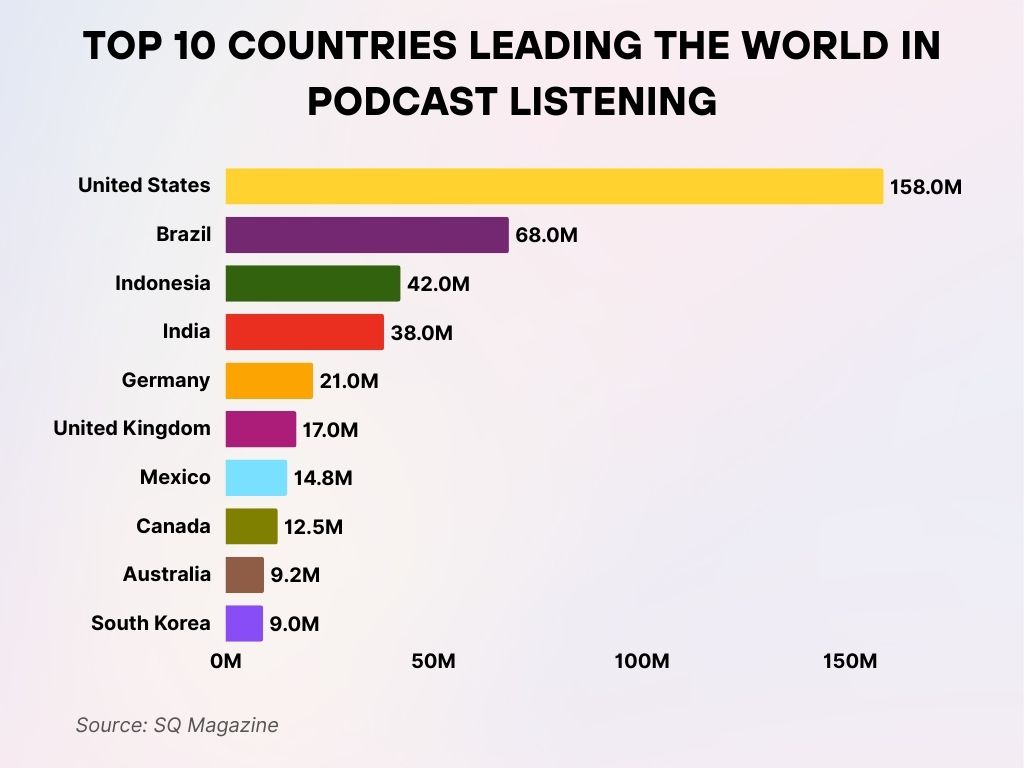
Recent Developments in the Podcast Industry
2025 has been a year of transformation, shaped by tech, policy, and creator innovation.
- Spotify launched an AI-powered podcast editor in early 2025, reducing production time by 30–40%.
- Apple Podcasts introduced community features, such as listener polls and live Q&A, to boost engagement.
- A new U.S. law now requires transparency in political advertising on podcasts, impacting monetization for news genres.
- Google announced tighter search integration for podcasts, improving discovery through episode-level SEO.
- Podcasting in cars became smoother with the rollout of 5G-optimized infotainment systems in 65% of new vehicles.
- Licensing models have changed, with more podcasters signing exclusive multi-platform deals rather than single-platform contracts.
- TikTok creators launched over 8,000 new podcasts in Q1 2025 alone.
- Major universities, including MIT and Stanford, added podcast creation modules to their media programs.
- The Podcast Standards Coalition introduced certification badges for shows meeting ethical and factual standards.
- AI voice replication tech sparked ethical debates after several podcasts experimented with synthetic co-hosts.
Conclusion
Podcasting in 2025 is a dynamic, fast-growing industry that spans languages, regions, platforms, and formats. With over 584 million global listeners, surging ad revenue, and powerful community engagement tools, the medium continues to solidify its place in the modern media landscape. As technology evolves and creators experiment boldly, podcasts are no longer just audio, they’re experiences, ecosystems, and cultural touchpoints shaping how we consume information and connect with the world.
Sources
- https://backlinko.com/podcast-stats
- https://www.statista.com/topics/3170/podcasting/
- https://thesocialshepherd.com/blog/podcast-statistics
- https://www.demandsage.com/podcast-statistics/
- https://prioridata.com/data/podcast-statistics/
- https://www.thepodcasthost.com/listening/podcast-industry-stats/
- https://riverside.fm/blog/podcast-statistics
- https://www.statista.com/topics/7662/podcasting-worldwide/









